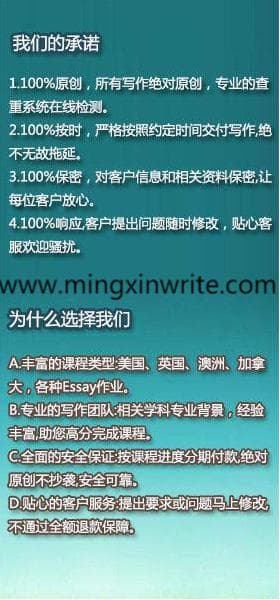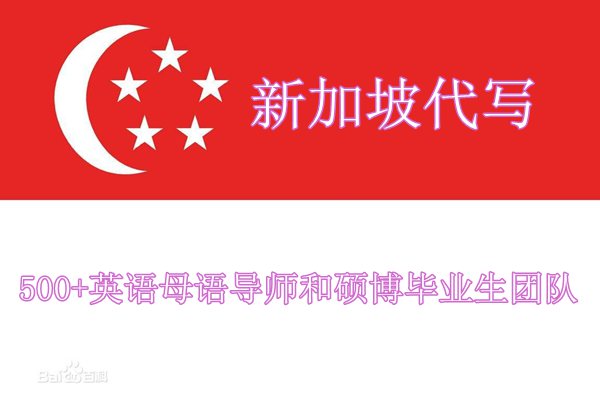发布时间:2020-11-01 热度:
新加坡论文代写服务|新加坡代写作业服务和代写文章服务,新加坡论文代写价格- essay代写,代写作业,新加坡论文代写推荐,专家团队在线指导。高学历专家导师。留学生一站式服务。论文服务。服务: 一对一跟踪反馈成绩, 助力3000+门课程拿A+, 24h在线接单。

新加坡留学生thesis写作思路和参考文献范例
Relationship between Real Estate Prices Shocks and Financial Credit Loans in Singapore
这一实证研究将研究住房价格的非对称性效应,以及住房价格的非线性转换。此外,它将研究如何通过住房价格波动的公式计算的住房价格波动影响金融贷款。
Contents
Abstract iii
1. Introduction
2. Literature Review
3. Data and Methodology
3.1. Data Description
3.2. Unit root tests
3.3. Non-linear transformations of housing price
3.4. Housing price volatility
3.5. Methodology of VAR model
4. Predicted Results
4.1. Methodology of VAR model
4.2. Asymmetric effects of housing price shocks
4.3. Effects of housing price volatility
References
Abstract
This paper begins with the current situation of housing prices in Singapore. In addition, this paper analyses the interaction between housing prices and financial credit loans. Then, based on the monthly data in 2001:1- 2014:12, it uses multi-VAR model to study empirically how the real estate volatility affect the financial credit loans in Singapore. This empirical study will research the asymmetric effects of housing prices shocks with non-linear transformations of housing price. Moreover, it will study how the housing price volatility effect the financial loansby the formula of housing price volatility.
Key words: real estate prices shocks; financial loans; housing price volatility; VAR model
Introduction
Real estate has dual characteristics of physical assets and virtual assets (Gimeno & Martinez-Carrascal, 2010). When considering real estate as virtual assets, the discounted present value of future expected returns is the determinants factor of the volatility of housing price, which make the volatility of real estate prices higher than the physical assets.
Singapore is one of the most economically developed regions in the world. The population density of Singapore is high and the growing rate of population is rapid. According to Department of Statistics of Singapore, in 2004, density of population is 7615 people/ km2. In other words, Singapore is also one of the most populous cities in the world. Moreover, in Singapore, there are two kind of residences: HDB flats and private properties. However, recently, the housing prices and trading volume of Singaporecontinue downward. Therefore, researching the relationships between real estate prices shocks and financial credit loans of Singapore has a great significance.
The structure of the empirical study is shown as follow. In section 3, I will present a brief statement of previous theoretical and empirical researches of how the housing prices effect the financial loans. I will describe the data sample of the empirical study in section 3. Section 4 will show the predicted result of the empirical study.
References
Abraham, J. M., & Hendershott, P. H. (1994). Bubbles in metropolitan housing markets (No. w4774). National Bureau of Economic Research.
Andersen, T. G., Bollerslev, T., Diebold, F. X., & Labys, P. (2001). Modeling and forecasting realized volatility (No. w8160). National Bureau of Economic Research.
Aoki, K., Proudman, J., & Vlieghe, G. (2004). House prices, consumption, and monetary policy: a financial accelerator approach. Journal of financial intermediation, 13(4), 414-435.
De Greef, I., & De Haas, R. (2000). Housing prices, bank lending, and monetary policy. In Financial Structure, Bank Behaviour and Monetary Policy in the EMU Conference (pp. 5-6).
Dickey, D. A., & Fuller, W. A. (1981). Likelihood Ratio Statistics for Autoregressive Time Series with a Unit Root. Econometrica, 49(4), 1057-72.
Gimeno, R., & Martinez-Carrascal, C. (2010). The relationship between house prices and house purchase loans: The Spanish case. Journal of Banking & Finance, 34(8), 1849-1855.
Goodhart, C., & Hofmann, B. (2008). House prices, money, credit, and the macroeconomy. Oxford Review of Economic Policy, 24(1), 180-205.
Hamilton, J. D. (1996). This is what happened to the oil price-macroeconomy relationship. Journal of Monetary Economics, 38(2), 215-220.
Hofmann, B. (2001). The determinants of private sector credit in industrialised countries: do property prices matter?.
Hofmann, B. (2003). Bank lending and property prices: Some international evidence.
Katkowski, D., Phillips, P. C., Schmidt, P., & Shin, Y. (1992). Testing the null hypothesis of stationarity against the alternative of a unit root: How sure are we that economic time series have a unit root?. Journal of econometrics,54(1), 159-178.
Liang, Q., & Cao, H. (2007). Property prices and bank lending in China. Journal of Asian Economics, 18(1), 63-75.
Mishkin F S. (1986). Stabilizing an Unstable Economy.New Haven, Conn.: Yale University Press.
Mishkin, F. S. (2007). The economics of money, banking, and financial markets. Pearson education.
Phillips, P. C., & Perron, P. (1988). Testing for a unit root in time series regression. Biometrika, 75(2), 335-346.
Quigley, J. M. (1999). Real estate prices and economic cycles. International Real Estate Review, 2(1), 1-20.
Semlali, M. A. S., & Collyns, M. C. (2002). Lending booms, real estate bubbles and the Asian crisis (No. 2-20). International Monetary Fund.
Sims, C. A. (1980). Macroeconomics and reality. Econometrica: Journal of the Econometric Society, 1-48.
The Singapore Department of Statistics 2015, Prices, Viewed 1 August
Von Peter, G. (2004). Asset prices and banking distress: a macroeconomic approach (No. 167). Bank for International Settlements.








